There is nothing I love more than a traditional Irish breakfast.
And living away from home, it means even more now as we cannot have it every week.
We either need to drive over an hour to an overseas supermarket to buy the staples at an inflated cost or wait for family to visit who usually bring the base ingredients with them.
The traditional Irish breakfast, often referred to as a Full Irish Breakfast or Irish Fry-Up, is a staple of Irish cuisine enjoyed for generations and can satisfy even the biggest appetites for most of the day.
This article gives you a look into what makes an Irish Breakfast so famous and its roots.
- Introduction to the Traditional Irish Breakfast
- Historical Context Behind the Irish Breakfast
- Key Components of a Traditional Irish Breakfast
- Cooking Methods
- Accompaniments and Beverages
- Where to Experience a Traditional Irish Breakfast
- Regional Variations
- Modern Variations and Dietary Considerations
- Conclusion
Introduction to the Traditional Irish Breakfast
The hearty meal which is a full Irish breakfast typically includes a combination of bacon, sausages, eggs, black pudding, white pudding, grilled tomatoes, and baked beans, all cooked to perfection and often served with soda bread or toast.
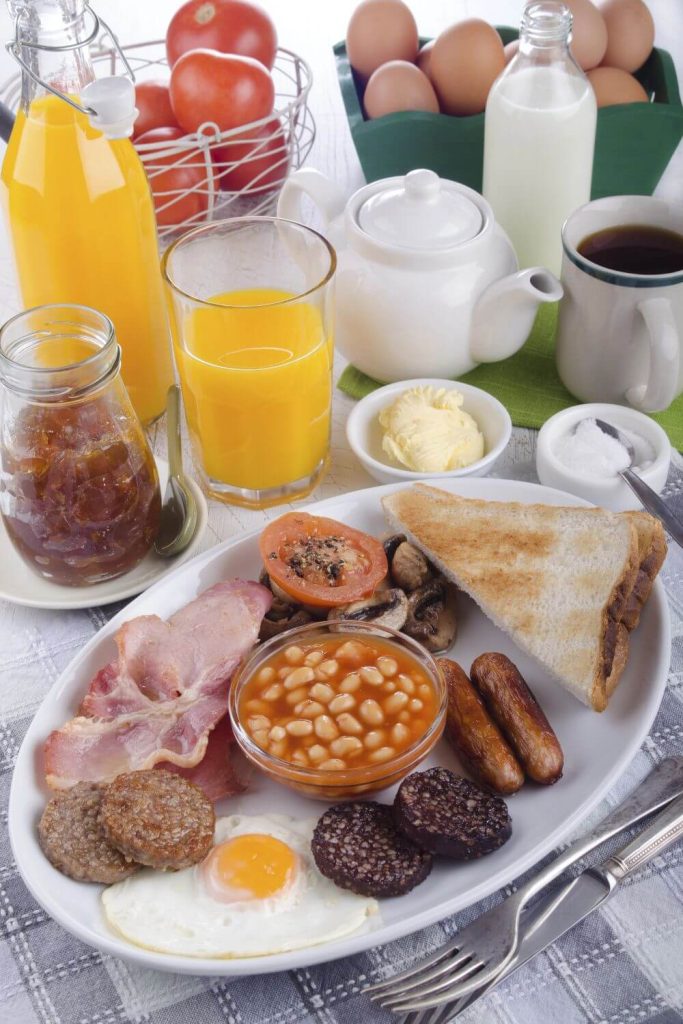
And it’s not just about the food; it’s about the cultural tradition of starting the day with a substantial and satisfying meal.
In Irish culture, breakfast holds a special significance as it brings families together and provides the energy needed for the day ahead. It’s a tradition that dates back to a time when a fulfilling breakfast was essential for those who worked long hours in farming and other physically demanding jobs.
The appeal of a traditional Irish breakfast lies not only in its rich and varied flavours but also in its ability to evoke a sense of nostalgia and connection to Irish heritage. A good Irish sausage takes me home every time I eat one.
As a modern Irish family, we continue to embrace this beloved breakfast ritual, keeping the tradition alive by enjoying it with our son as often as we can.
Historical Context Behind the Irish Breakfast
The traditional Irish breakfast has its roots in the agricultural communities of Ireland.
Farmers required a hearty meal to start their day, providing them with the energy needed for labour-intensive work. This meal typically included staples such as eggs, sausages, and bacon.
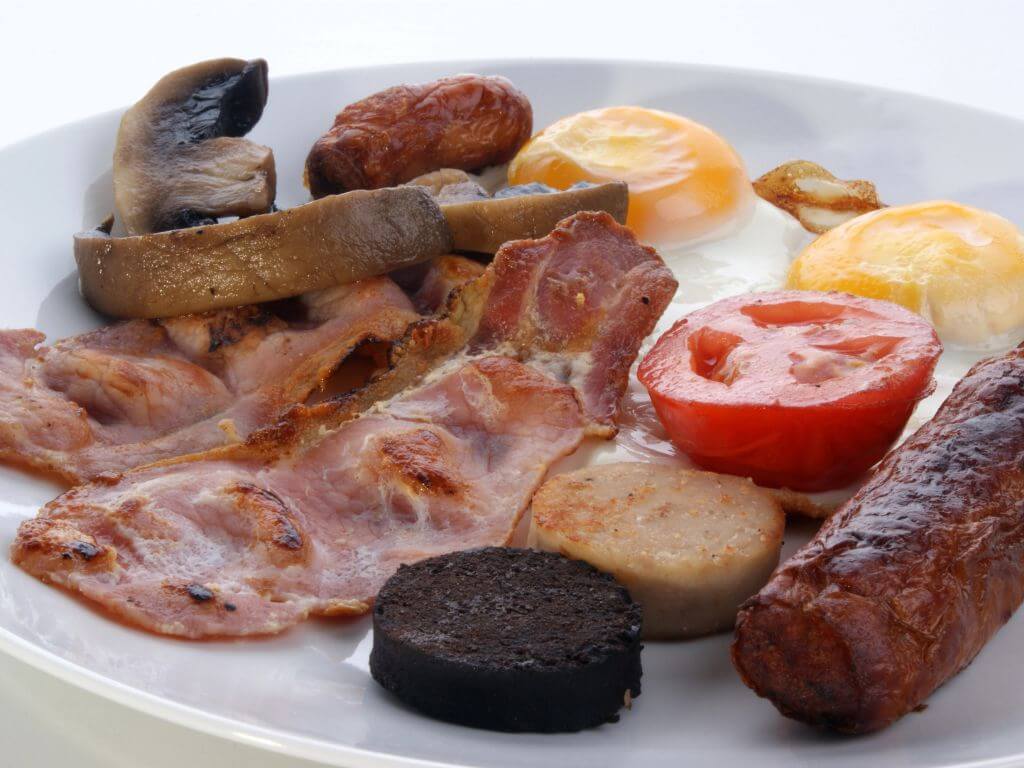
Over time, the composition of the breakfast evolved, influenced by availability and regional preferences.
For example, the Ulster Fry is a notable variation, adding items like soda bread and potato farls.
Even though the full Irish breakfast was initially a rural tradition, it became widely available in hotels and guesthouses. Many offer a full Irish breakfast to guests staying with them. The result was this meal eventually took on cultural significance, symbolising Irish hospitality. It wasn’t just about sustenance but about community and sharing.
Components Commonly Found in an Irish Breakfast:
- Rashers (Bacon)
- Sausages
- Black and White Pudding
- Eggs
- Grilled Tomatoes
- Baked Beans
- Sautéed Mushrooms
- Toast or Soda Bread
The breakfast remains a part of Irish identity, reflecting its agricultural heritage and social customs. This rich tradition is celebrated not just in Ireland but by Irish communities worldwide.
Key Components of a Traditional Irish Breakfast
A traditional Irish breakfast is a hearty meal that typically includes a variety of meats, eggs, dairy, breads, vegetables, and legumes. Each component offers a unique taste and texture, making for a fulfilling and balanced plate.
Let’s look at each component.
Meats
The meat selection usually features bacon, sausages, black pudding, and white pudding. Bacon rashers, often referred to as back bacon, are thicker than standard bacon and are characterised by their balance of fat and meat.
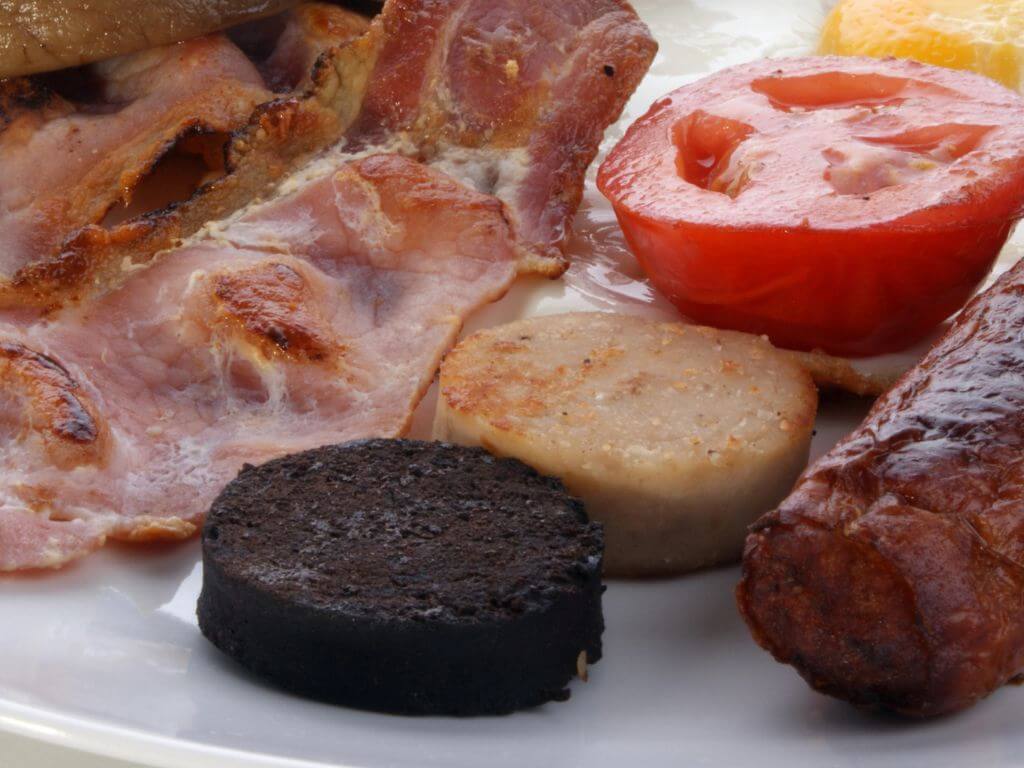
Sausages are pork sausages and the full Irish will also include pudding of two types: traditional Irish black pudding, which is a type of blood sausage made from pork blood, fat, and oatmeal, while white pudding is similar in texture but lacks the blood, making it milder.
Personally, I prefer white over black but will eat black if that’s all that is on offer.
Eggs and Dairy
Eggs are a crucial part of an Irish breakfast, prepared in various methods such as fried, scrambled, or poached. Fresh, local eggs are preferred for their flavour and quality.
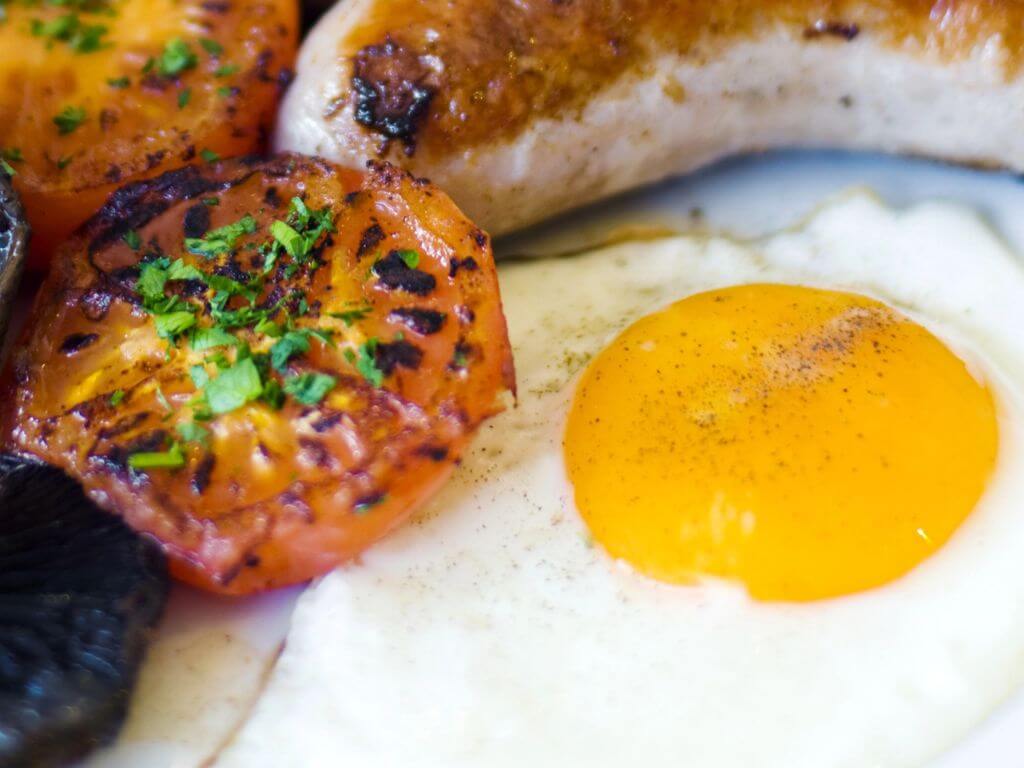
Adding to the richness, Irish butter may accompany the meal, known for its creamy texture and distinct taste. Whether you are having toast or soda bread, nothing tastes nicer than Irish sausages on bread lathered in rich Irish butter. Kerrygold is my personal favourite.
Breads
Soda bread is a staple on the plate, recognisable for its slightly tangy flavour due to the use of baking soda instead of yeast.
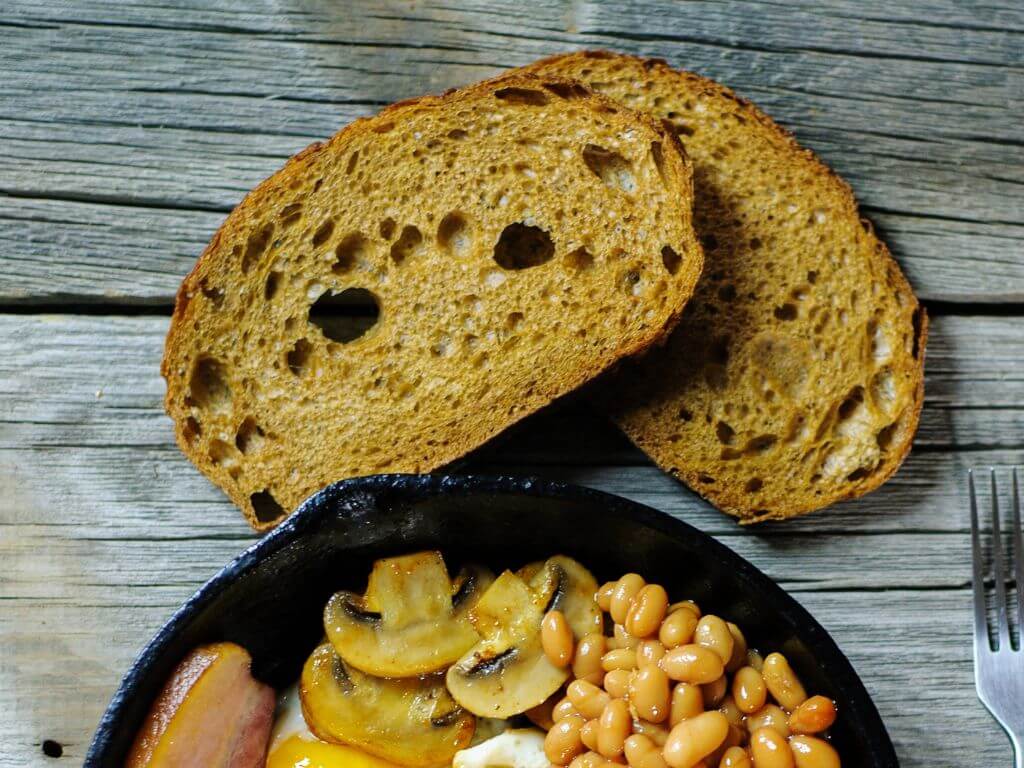
It may be served alongside toasted Irish bread, either brown or white, although white is more common. Toasted Brennans bread is the way to go!
These breads are typically slathered with butter, enhancing the sensory experience of the meal.
Vegetables and Legumes
Tomatoes may be another accompaniment. If served, they are usually fried until slightly caramelised, adding a hint of sweetness to the savoury elements. Additionally, sautéed mushrooms may also be served, typically cooked in garlic and butter.
Baked beans finish off the meal, offering a creamy texture and a touch of sweetness.
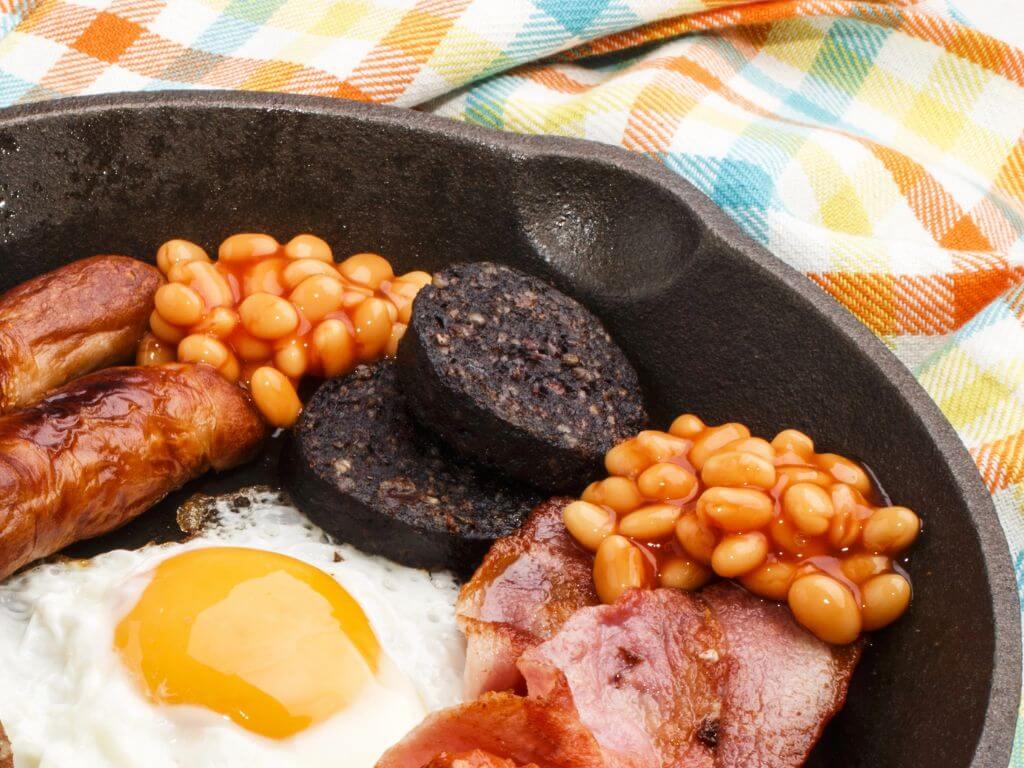
These vegetables and legumes not only add variety but also help balance the richness of the other components, which can sometimes feel meat-heavy without them.
This arrangement highlights why the traditional Irish breakfast is both cherished and satisfying.
Cooking Methods
Cooking a traditional Irish breakfast involves various techniques to achieve the perfect balance of flavours and textures. This section explains the frying, baking, and alternative methods used to prepare a traditional Irish breakfast.
Frying Techniques
Frying is central to cooking a traditional Irish breakfast. It usually involves using a frying pan or skillet. Key ingredients like sausages, bacon, and fried eggs are typically prepared this way.
A fry-up can also include grilled tomatoes, which can be lightly fried to soften and enhance their taste.
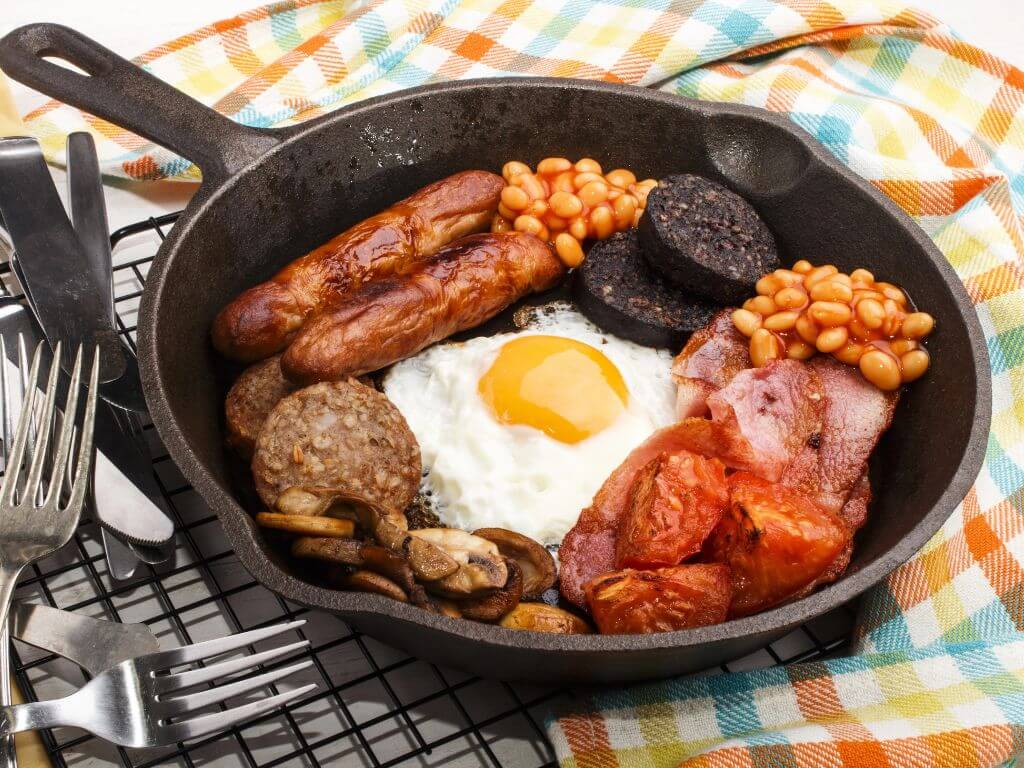
Items should be cooked over medium heat, ensuring they are browned and cooked through without being burnt. Every component must be fried separately to avoid flavour mixing and maintain the unique taste of each ingredient.
In order to allow this, I keep each component warm in an oven until everything is ready to put on the table for people to dig in.
Baking and Grilling
For a lighter approach, some parts of the breakfast can be baked or grilled. This method is especially great for components like grilled tomatoes or even the sausages.
Baking is my preferred method as it means you can ensure everything comes together at once and you don’t add unnecessary fat in the form of oil to your breakfast.
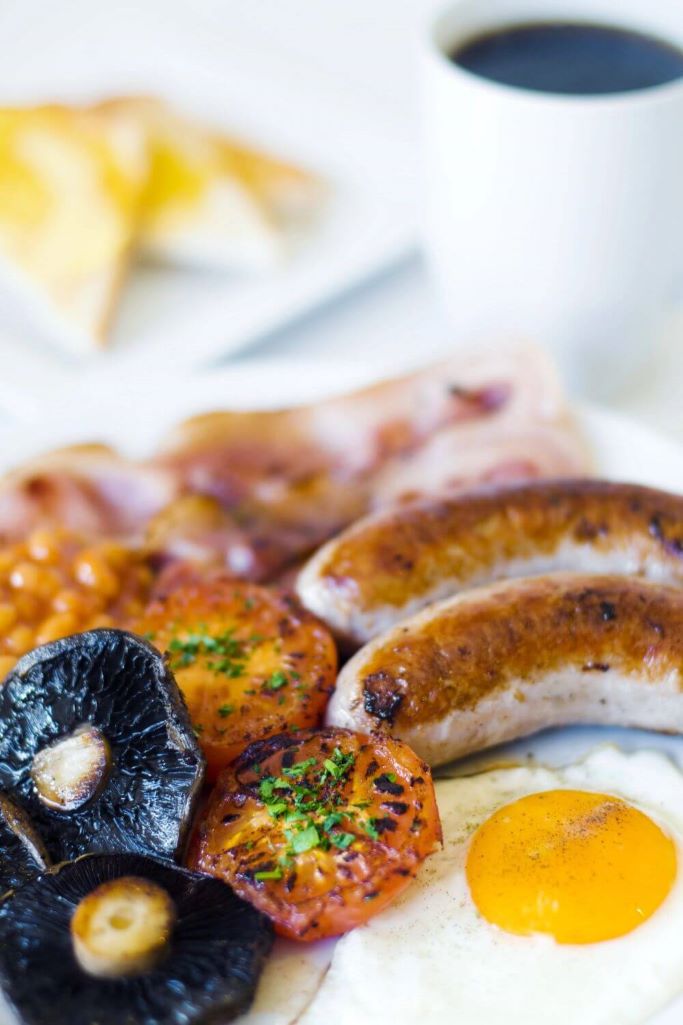
The oven should be preheated to between 180 and 200°C. Place sausages, pudding and rashers on a baking sheet or aluminium foil in a tray, and grill the tomatoes on a rack, allowing the juice to drip down and prevent sogginess.
Baking ensures an even cooking process, helping reduce fat compared to frying. Additionally, black pudding and white pudding can be baked or grilled to crisp the exterior while keeping the inside moist.
Alternative Cooking Styles
While frying and baking are prevalent, there are other techniques available. Using an air fryer can reduce fat content while still providing a crispy texture for sausages and bacon.
Another method is poaching eggs in water rather than frying them in oil, which offers a healthier alternative.
Prepping vegetables like mushrooms and tomatoes in a steamer can also provide a fresher, nutrient-rich option, but I don’t do this.
These methods allow for a versatile and potentially healthier rendition of a traditional Irish breakfast.
Accompaniments and Beverages
A traditional Irish breakfast isn’t complete without a range of beverages and accompaniments. These items enhance the flavours and provide a more rounded meal experience.
Hot Beverages
Tea and coffee are staples. Irish breakfast tea, known for its robust flavour, is the preferred choice. It’s typically brewed strong and served with milk and sugar, although I have mine almost black.
And there is the never-ending argument over whether you prefer Lyons or Barrys Tea. We’re a Lyons family.
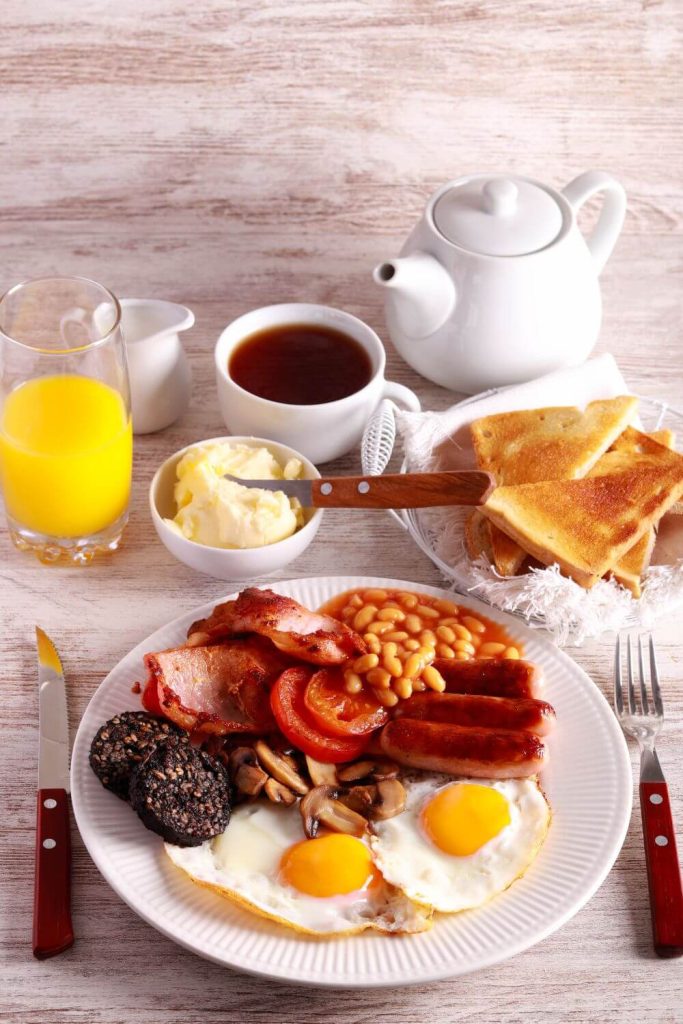
Coffee is also popular, often served black or with milk.
Both beverages are enjoyed hot, providing a comforting and awakening start to the day.
Condiments and Extras
Condiments play a key role. Butter, marmalade, and jam are typically spread on toast.
Ketchup and brown sauce add tangy and savoury notes to the meats and eggs. These sauces are quite popular and often found on the dining table.
And again, there is an argument for and against brown sauce. It is considered a very British addition to the breakfast meal, so we are a no brown sauce family.
Side Items
Freshly squeezed orange juice or plain orange juice provides a refreshing contrast to the heaviness of the cooked items. This can ensure a nutritious and complete breakfast.
Where to Experience a Traditional Irish Breakfast
One of the best places to enjoy a traditional Irish breakfast is in local restaurants and cafés across Ireland.
Establishments like Bewley’s in Dublin or Gallagher’s Gastro Pub in Cork are renowned for their hearty morning meals. These places offer an authentic experience with the freshest ingredients.
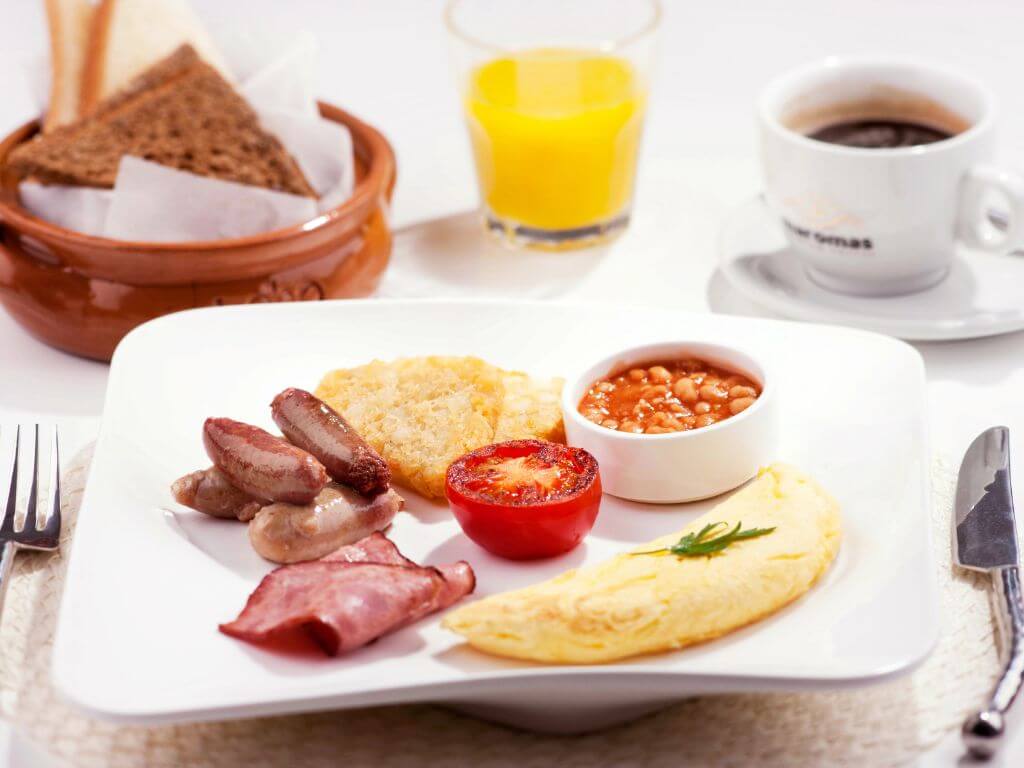
Many Bed & Breakfasts also serve excellent traditional Irish breakfasts. Staying at a B&B provides a cosy atmosphere and a chance to start the day with home-cooked food. It is also a great way to get to know your hosts and maybe find out some locals gems to visit from them.
Hotels across the country frequently feature traditional Irish breakfast options. For example, the Shelbourne Hotel in Dublin and the Hayfield Manor in Cork are known for their excellent morning spreads. They provide both comfort and a classic Irish culinary experience.
Most Irish hotels offer a full Irish breakfast, and I can recommend the breakfasts in both The Alex and The Grafton Hotels in Dublin. The breakfast choice in Kilkea Castle in County Kildare is also fantastic.
When in Galway, one can try Ard Bia at Nimmo’s. This spot combines a picturesque location with a delightful breakfast. Situated close to the Spanish Arch, it’s a must-visit for anyone seeking an Irish breakfast in a unique setting.
In rural areas, small-town cafés often serve the most authentic versions. Places like Kate Kearney’s Cottage in County Kerry offer breakfast with stunning views and a warm, welcoming atmosphere. This adds a special touch to the dining experience.
Regional Variations
Traditional Irish breakfasts vary considerably depending on the region, showcasing unique ingredients and distinct preparation methods. Diverse elements such as the Ulster Fry and city-specific specials highlight the rich culinary tradition.
Ulster Fry
The Ulster Fry, a staple of Northern Ireland, features renowned ingredients like potato bread and soda farls. It’s particularly known for including both white and black pudding.
Boxty, a type of potato pancake, may also appear on plates. These distinct elements set it apart from other Irish fry-ups, forming a hearty and flavourful meal.
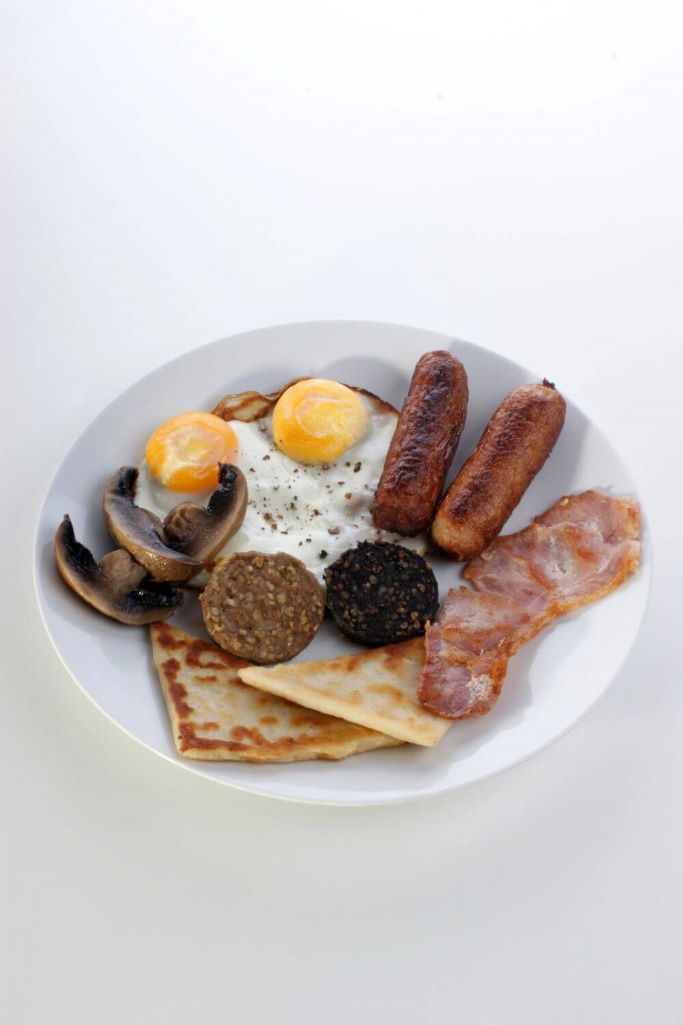
Southern Irish Varieties
Southern Ireland features variations which might include the Waterford Blaa, a soft, floury bread roll. Breakfasts here often come with boxty and Irish potato bread.
The southern version emphasises local ingredients, providing a different take on the classic fry-up. This variation offers a slightly lighter, yet equally satisfying, experience.
City-Specific Specials
In cities such as Dublin and Cork, special elements are added to the breakfast table. Dublin’s breakfast might include a different style of sausage and a lighter use of puddings.
City specials reflect regional tastes and an urban twist on traditional fare. These varieties often cater to diverse palates, blending tradition with contemporary tastes.
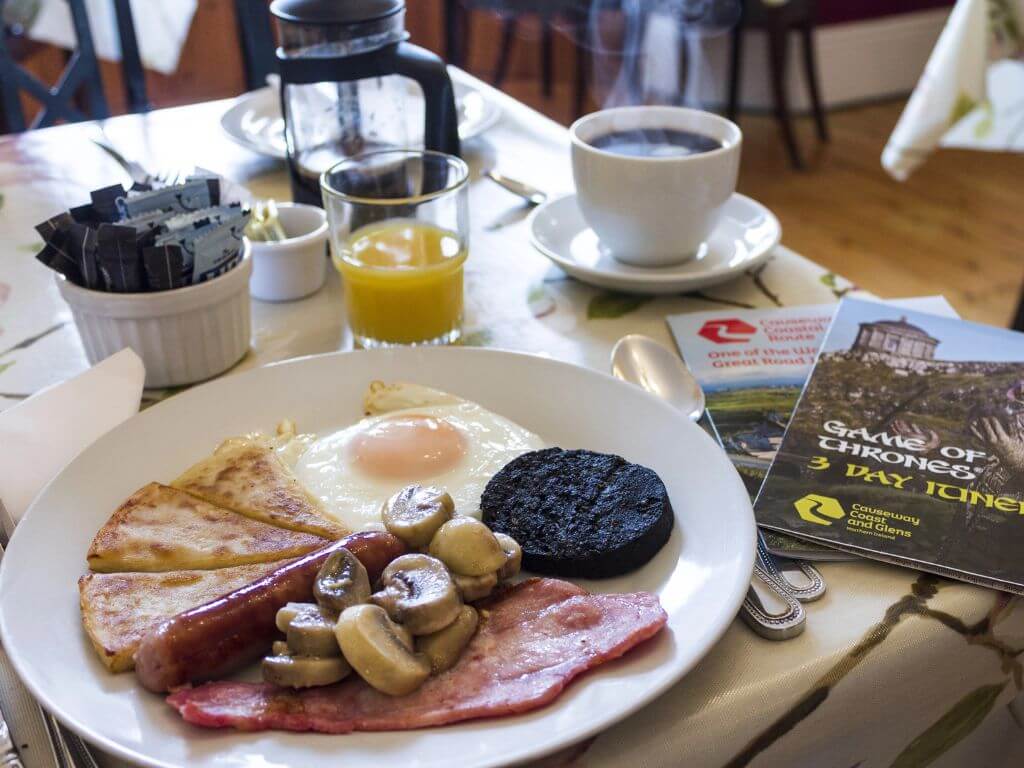
Modern Variations and Dietary Considerations
Traditional Irish breakfasts have seen numerous contemporary twists to suit modern tastes and dietary needs. These variations often aim to provide healthier alternatives or cater to vegetarian and vegan diets.
Vegetarian and Vegan Options
The traditional meat components are substituted with plant-based proteins. Vegan sausages, tofu scrambles, or tempeh bacon are popular choices. Mushrooms, potatoes, and tomatoes still play a central role.
Healthy Alternatives
For those seeking lighter options, grilled or baked items can replace fried foods. Tomatoes are often roasted rather than fried. Oats can be used as a base for porridge, providing a nutritious start.
Functional Ingredients
Inclusion of herbs and veggies like spinach or kale adds freshness and nutrients. Avocado has also become a popular addition, but wouldn’t necessarily be considered traditional.
Protein Sources
Traditional meat-based proteins are swapped with legumes, beans, or leaner meat like turkey bacon. This keeps the meal high in protein while reducing fat content.
Sample Modern Irish Breakfast
| Traditional Version | Modern Variation |
| Fried sausages | Vegan sausages |
| Fried eggs | Tofu scramble |
| Fried Tomatoes | Roasted Tomatoes |
| Bacon | Tempeh Bacon |
| Fried Bread | Wholegrain Toast |
| Black pudding | Black bean patties |
| Baked beans | Mixed beans with herbs |
In summary, modern versions of the traditional Irish breakfast are diverse, catering to various dietary preferences without compromising on taste.
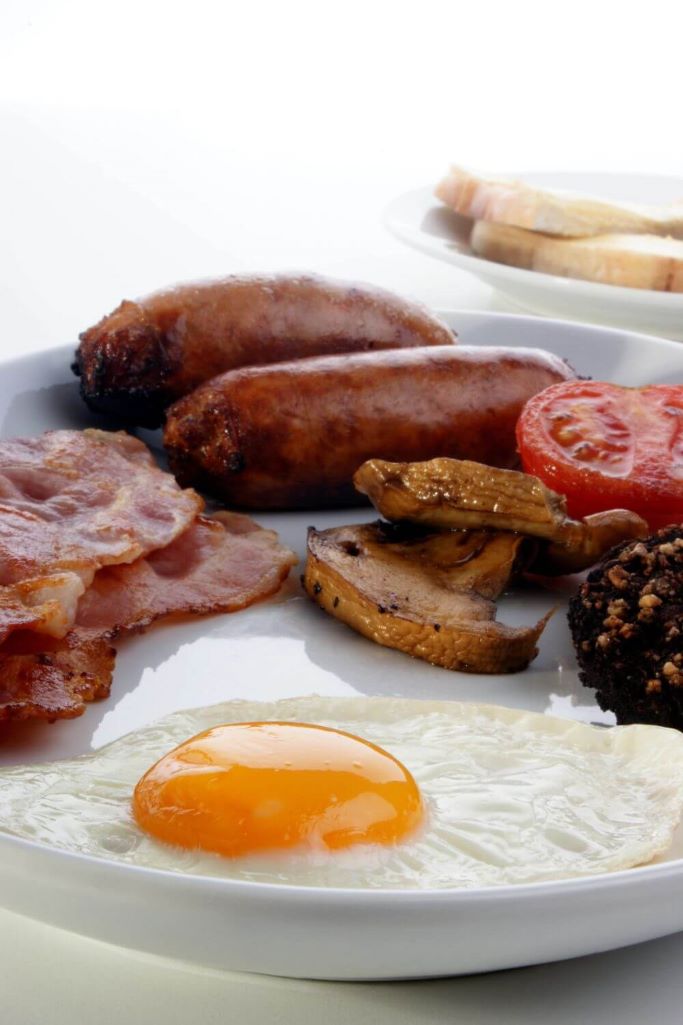
Conclusion
The traditional Irish breakfast remains a beloved and integral part of Irish culture. Its hearty combination of ingredients reflects the warmth and hospitality of Irish cuisine.
I encourage travellers to Ireland to savour this meal to truly appreciate its rich culinary heritage.
Experiencing a traditional Irish breakfast can offer an authentic taste of Ireland’s history and traditions. Whether in a cosy bed and breakfast or a bustling city café, this meal is a symbol of enduring Irish hospitality.
And, it will set you up nicely for a full day of sightseeing!
You might also enjoy reading:
Pin for later
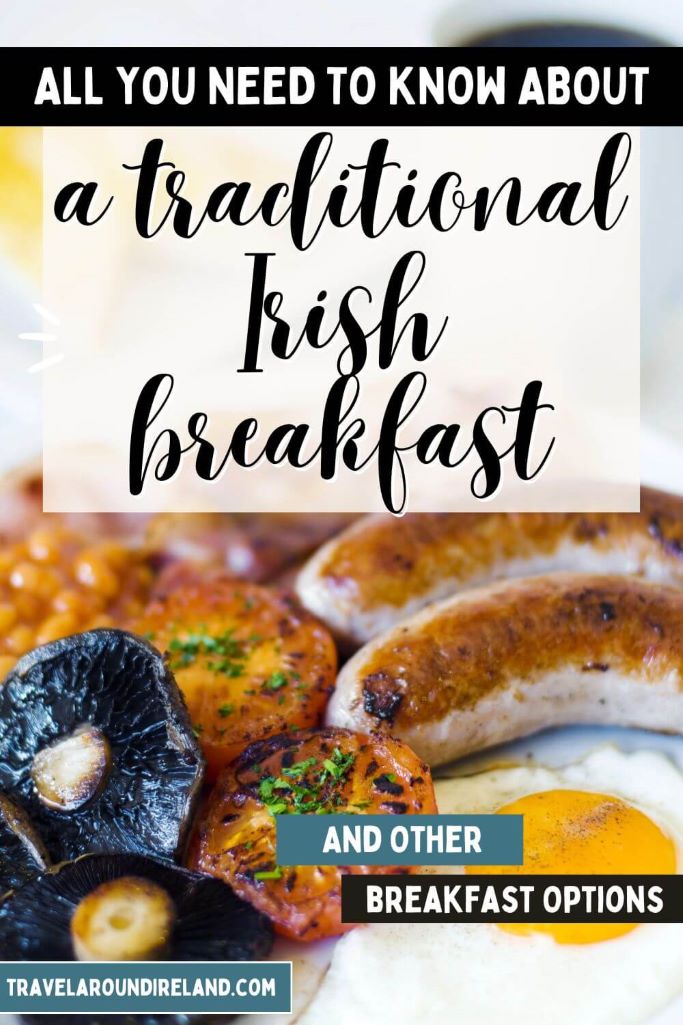
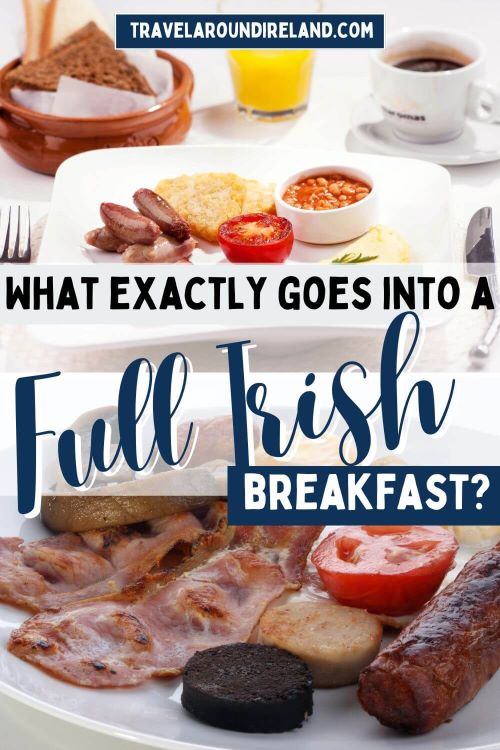
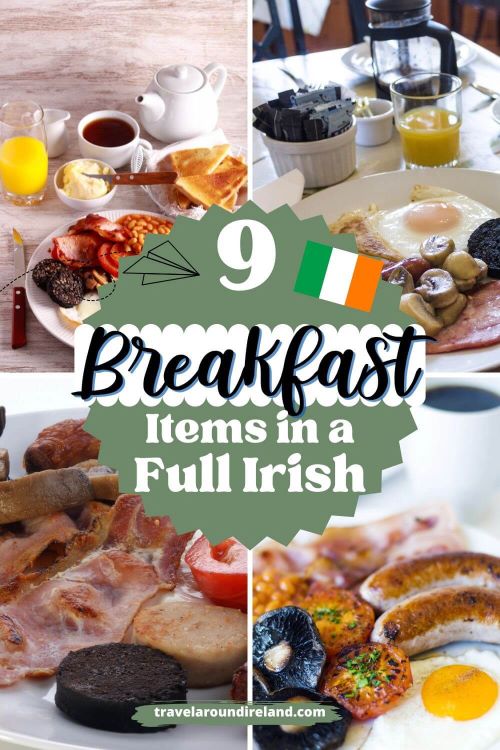

I’m English but think the midwife got things mixed up because I’ve always yearned
to be Irish! – love the Irish passion humour – Young Offenders and second to none
with countless dramas you can inhale the tension! When I see scenes of Cork and
Dublin they seem like my spiritual home though I’ve never been! In the middle of
writing a production Not a Dry Eye in The House featuring the music of Meat Loaf
couldn’t resist casting the main four characters as Irish – Davey Bullen his lady
Jenna Gregan and Declan Strings Regan and wife Anna Regan. Guess if Meat Loaf
was still around a Full Irish Breakfast in Dublin or Cork would be my idea of Heaven!
And sod that midwife!